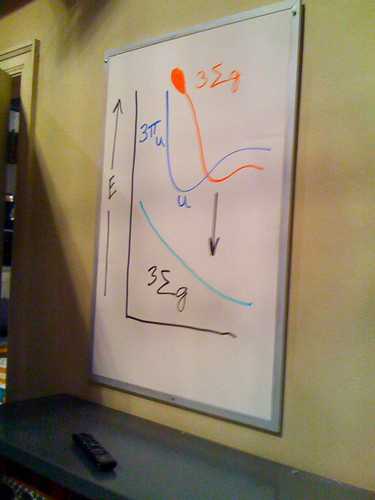Blueshift ponders… when does Hollywood get it right?
- By Maggie Masetti
- October 21, 2010
- 3 Comments
We’re avid readers of Dr. David Saltzberg’s blog, The Big Blog Theory. As the science advisor for The Big Bang Theory, he blogs after each episode airs to give an in-depth explanation of the episode’s science. Last week’s blog caught our eye because, well, it’s about the episode that must have been filmed right before our visit to the show’s set!
In the blog, Dr. Saltzberg talks about what is written on the whiteboards in Leonard and Sheldon’s apartment in the episode “The Hot Troll Deviation.” Here’s a photo that we snapped:
Any guesses as to what is being graphed here? Hint: It’s from a movie!
Which brings us to our question…
What is your favorite or least favorite bit of science in a movie? (TV shows are also acceptable.) We actually did a podcast about some of the questionable (or downright awful) science in movies – but here’s your chance to weigh in!
While you take a moment to think about the science in movies that’s made you smile or cringe, here’s more about the whiteboard from The Big Bang Theory that we showed above. This whiteboard is… nearly identical to one seen in the 1985 movie Real Genius!
Says Val Kilmer’s character in the film, “It’s a chemical laser but in solid, not gaseous, form. Put simply… it’s like lasing a stick of dynamite. As soon as we apply a field, we couple to a state, it is radiatively coupled to the ground state. I figure we can extract at least ten to the twenty-first photons per cubic centimeter which will give one kilojoule per cubic centimeter at 600 nanometers, or, one megajoule per liter.”
Whether or not that is “real” science is left as an exercise to the reader. However, Real Genius did have a science consultant, USC physics professor Martin Gundersen. Dr. Saltzberg writes about inviting him to the set of The Big Bang Theory to see the white board – and there’s even a picture of him with it!
Now, here are Blueshift’s thoughts about movie science:
Maggie: I appreciate the effort put into things written on white boards because when I was in college I remember watching the movie I.Q. – it’s set at Princeton, and Albert Einstein is a character. His niece (Meg Ryan) is a mathematician – and in the end she “solves” the big scientific problem (which I think was either proving or disproving cold fusion) by basically writing down the equation for conservation of energy. She used fancy scientific notation though, so to anyone but a physics major, it probably would have looked more convincing! It’s been years since I actually saw that movie, but I remember being really indignant at the time.
As for good science – I always appreciate when movies don’t use sound in space.
Sara: This is a tough question, because it’s much easier to think of films with really, really atrocious science! I loved Real Genius when I was growing up, and it always felt like believable science… now I’m glad to know that it is! I think Contact has a really special place in my science-loving heart, because it works very hard to keep its science accurate and reasonable. It’s got some great sci-fi elements, but they are grounded in reality and I appreciate that. Since the movie is based on Carl Sagan’s work, it would’ve been tragic for them to get it really wrong. Phil Plait has some nitpicks (caution: spoilers), but it’s really a great example of a film that gets a lot of things perfectly right.
I’ll also toss in a shout-out to the independent film Primer, which is such a rich and mind-bending portrayal of time travel that I’ve watched it again and again to catch all of the details. There are lots of discussions and graphics all over the internet that try to explain the movie’s timeline. Now I think I have to watch it again…
Now we want to know – what movies do you appreciate for featuring good science? Tell us in the comments! We might just add some new films to our queue for upcoming movie nights…
Comments are moderated and we ask that you be respectful. No profanity please! Any comments with non-NASA links may be edited or removed.
Disclaimer: All opinions in this blog entry are that of specific individuals and do not represent those of NASA, Goddard Space Flight Center, or Blueshift.





The potential energy curves drawn on the board are for an excimer. An excimer, or exciplex, is a compound between two (gaseous) atoms that only have bound excited electronic states, and are purely repulsive in the ground state. An excimer laser (such as argon fluoride, xenon chloride) works by creating excited state atoms, which combine to form an excimer, which then relaxes by release of a photon. When enough photons are release (in an optical cavity) then stimulated emission dominates the process and laser light is created. These lasers produce some of the most extreme UV laser light and are very commonly used. The experimental concept used in Real Genius is to trap the excited state complex (exciplex) in a cryogenic matrix until they reach much higher density than can be achieved in the gas phase, thereby gaining “a whole ‘nother order of magnitude” more power. This was a movie quote we used often in grad school.
Thanks for your comment, Greg! I knew it was for an excimer laser – but not exactly how it’s supposed to work! :-)
Not sure on the science of this movie but I wonder what your thoughts are on the new movie apollo 18?